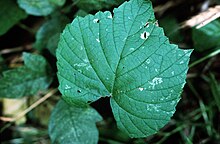This article includes a list of general references, but it lacks sufficient corresponding inline citations. (May 2011) |
| Frost grape | |
|---|---|

| |
| Scientific classification | |
| Kingdom: | Plantae |
| Clade: | Tracheophytes |
| Clade: | Angiosperms |
| Clade: | Eudicots |
| Clade: | Rosids |
| Order: | Vitales |
| Family: | Vitaceae |
| Genus: | Vitis |
| Species: | V. vulpina
|
| Binomial name | |
| Vitis vulpina | |
| Synonyms[2][3][4][5][6] | |
|
V. cordifolia Michx. | |
Vitis vulpina (with common names frost grape,[2] winter grape,[1][2] fox grape,[7] and wild grape.[7]) is a North American species of herbaceous perennial vines in the grape family. It is widespread across most of the eastern and central United States as well as the Canadian Province of Ontario.[2][8]
The genus name Vitis comes from the Latin word for "vine" and the species name vulpina comes from the Latin word for "fox-like" or belonging to a fox. It is believed that foxes were attracted to this type of grapevine, and Linnaeus used the term vulpina to differentiate these smaller wild grapes from the other American known grapes. The more common name, frost grape, refers to the fact that this otherwise acidic/tart-tasting grape becomes more desirable and sweet once it is exposed to a frost. Vitis vulpina is a high-climbing woody vine with a thick trunk and red tendrils. The grapes and the vine itself have many uses ranging from herbal remedies to edible delicacies.
- ^ a b Vitis vulpina was first published in Species Plantarum 1: 203. 1753. "Vitis vulpina". Germplasm Resources Information Network. Agricultural Research Service, United States Department of Agriculture. Retrieved May 18, 2011.
- ^ a b c d "Profile for Vitis vulpina L. (frost grape)". PLANTS Database. USDA, NRCS. Retrieved May 18, 2011.
- ^ Vitis cordifolia was first published in Flora Boreali-Americana (Michaux) 2: 231. 1803 (non Lam. 1793) GRIN (January 15, 2011). "Vitis cordifolia information from NPGS/GRIN". Taxonomy for Plants. National Germplasm Resources Laboratory, Beltsville, Maryland: USDA, ARS, National Genetic Resources Program. Retrieved May 18, 2011.
Synonym of Vitis vulpina L.; an illegitimate later homonym (Vienna ICBN Art. 53) that is unavailable for use; a taxonomic, not nomenclatural, synonym of V. cordifolia Lam.
- ^ Vitis cordifolia var. foetida was first published in: American Naturalist 2(6): 321. 1868. "Name - Vitis cordifolia var. foetida Engelm". Tropicos. Saint Louis, Missouri: Missouri Botanical Garden. Retrieved May 18, 2011.
- ^ Vitis cordifolia var. sempervirens was first published in Rev. Vitic. 5: 165. 1896 10990 "Plant Name Details for Vitis cordifolia var. sempervirens". IPNI. Retrieved May 18, 2011.
Distribution: Manatee County (Florida, Southeastern U.S.A., Northern America)
- ^ Vitis illex was first published in Gentes Herbarum; Occasional Papers on the Kinds of Plants. [Hortorium, Cornell University] iii. 217 (1934). "Plant Name Details for Vitis illex". IPNI. Retrieved May 18, 2011.
- ^ a b ITIS Report, retrieved 7 July 2015
- ^ Biota of North America Program 2014 county distribution map